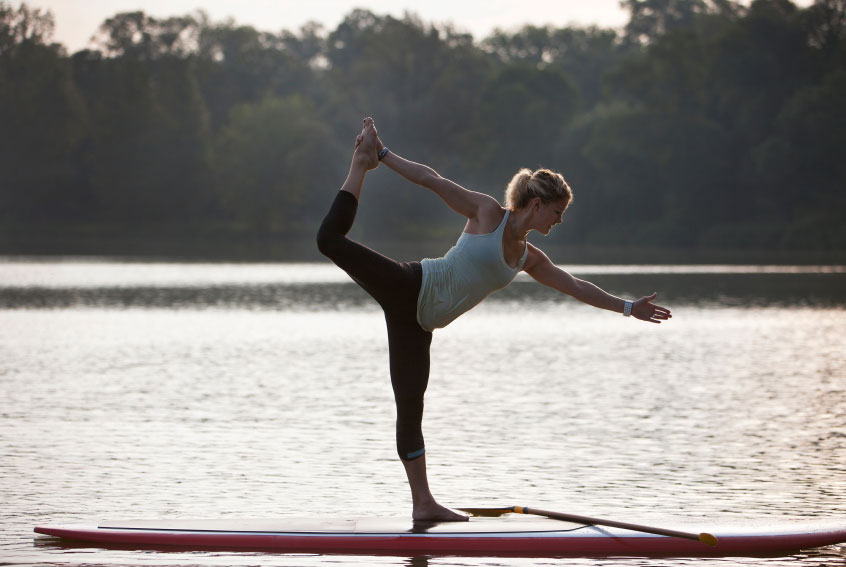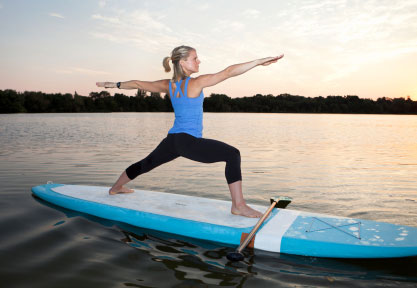Whether you’re looking to boost your yoga practice, your paddleboard enjoyment, your sense of empowerment or to simply have fun, SUP yoga can be the answer.

What It Is
Standup paddleboard yoga is the official name of the sport, although those in the know simply refer to it as SUP yoga. And more and more folks are becoming in the know.
While it’s tough to pinpoint the exact origin of the art, certain yogis have been practicing SUP yoga for years, way before the steady stream of SUP classes hit the lakes and bays where SUP yoga is increasingly showing up. The sport involves performing yoga poses on a paddleboard, which propels your yoga practice to an amazing new level.
What You Need
You need a paddleboard for the sport, of course, but you should also have a bit of mastery of at least the most basic yoga poses. SUP yoga typically requires a board that is between 10 to 12 feet long and between 29 and 32 inches wide. A standard or all-around type of board can do the trick, since it typically provides adequate buoyancy and stability to accommodate your yoga moves.
Manufacturers have already hopped on the bandwagon with boards designed specifically for a water-bound yoga practice. While you’ll want a paddle to get around the lake or bay, you don’t need one to practice the poses.
How to Get Started
Once you’re armed with your board and mastery of basic yoga poses, you additionally need to embrace the idea that you’re going to fall. Falling is par for the course and also part of the fun.
Taking yourself too seriously or fearing a tumble into the water can put an instant wet blanket on your practice, pun not intended. Adjust your attitude to one of playfulness, fearlessness and adventure and you’ll be ready to go.
Starting with several grounding poses helps you get you balance. Go for the simpler Child’s Pose and Cat Cow Pose for starters, then move to the more advanced standing poses that require more precision and attention to balance.
Tree Pose, Warrior I Pose and Downward-Facing Dog can work well on a standup board, provided you evenly distribute your weight. Using a wider stance than you do on dry land can help stabilize your poses, as can rocking with the water’s motion instead of fighting it against it.
Helpful Hints
Another key to an effective SUP yoga practice is to shift your focus. Instead of only focusing on your poses, you need to take into account how your movements affect your board. Transitioning from a Downward-Facing Dog to a Forward Lunge, for example, can thrust your board forward and you right off it.
Micro-movements are the answer, with the keen awareness that each little shift will have an impact on the alignment of both you and your board. Fixing your gaze on a point along the shore, horizon or on a stable rock or landmark can also help you remain balanced and stable.
Adjusting the angle or positioning of your feet and hands to achieve improved balance is allowed, as are other small variations in the poses that help you better achieve and maintain stability. And yes, you’re allowed to grab the side of your board just to stay on board or otherwise stabilize what could turn into a capsize.
What You Get Out of It
Absolutely freedom tops the list of benefits from SUP yoga, and that freedom starts with the ability to let go.
- Let go of the idea that you must do every pose perfectly
- Let go of judgments and expectations
- Let go of the idea that yoga is all work and no fun
- Let go the manacles that bind you to your mind and offer control to your heart
As with any yoga practice, SUP yoga takes you beyond the physical and into the realms of mental and spiritual enlightenment where you can truly connect with the world around you. That connection can come pretty much automatically just from floating in the middle of a glorious span of nature.
Additional benefits of SUP yoga include:
Colossal core workout: Because the water is in constant motion, your core muscles are constantly at work to keep you stable on top of it.
Activation of tiny muscles: Not only does the water’s constant motion make your core work harder, it also activates tiny muscles throughout your entire body. Muscles in your arms and legs that don’t normally need to come into play during your earthbound yoga practice can play key roles when you’re doing yoga on the water.
Greater challenge: Yoga on a floating board leaves far less room for mistakes than yoga on dry land. Your poses become more precise and your technique more refined. Your veering or lilting board will let you instantly know when your balance is off. Mixing up your exercise routine is always a good move to keep your body challenged and out of a rut in which exercises are no longer effective.
Greater relaxation: Your wide open, natural surroundings can automatically provide a greater dose of serenity than the yoga studio’s four walls. The sound of the water can add another layer of calm while helping you focus on your breath.
And floating around? Another point for relaxation, as it can instantly lift the heaviness that often weighs on the heart or turns your shoulders into a knotted mess.
Life lessons: Falling is not only par for the course with SUP yoga, but it is par for the course with life. Even if you don’t physically fall down, life is quite adept at throwing curve balls that can catch us off-balance and even result in failure.
The big lesson here is not to simply fall down and accept it, but to fall down and get back up. Every time you get back on your board after a tumble can be considered one more victory in your cap.
SupBoardGuide Editorial Team
Latest posts by SupBoardGuide Editorial Team (see all)
- Nautical 10’6 SUP Board Review – 2024 - January 30, 2024
- Gili Sports Air 10’6″ Review - September 19, 2023
- Best Cheap Inflatable Paddle Boards (2024) - July 31, 2023


The awesome part of SUP Yoga is that you are floating on the water, realizing that you are in nature combining the elements of air and water and practicing a true healing art!!